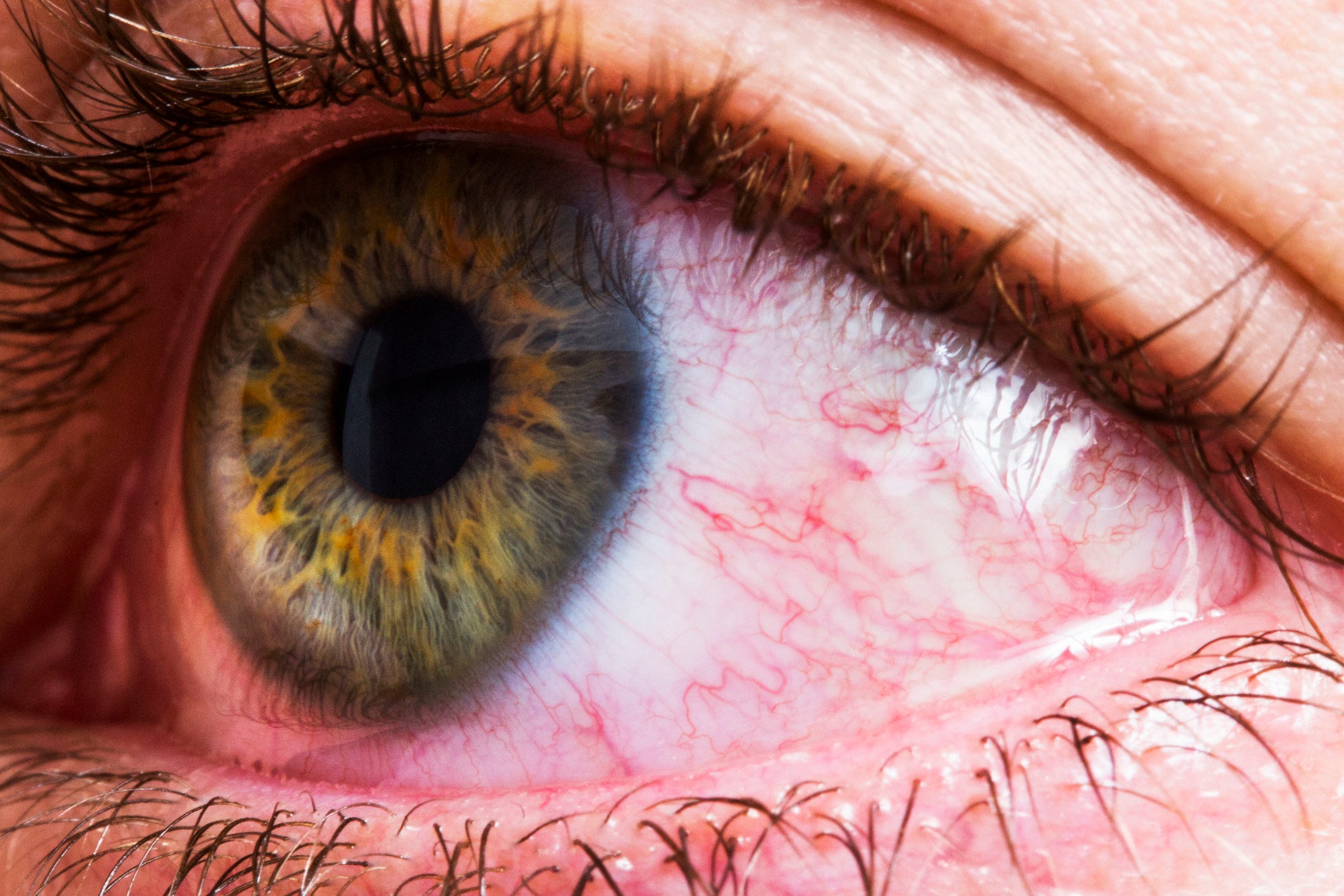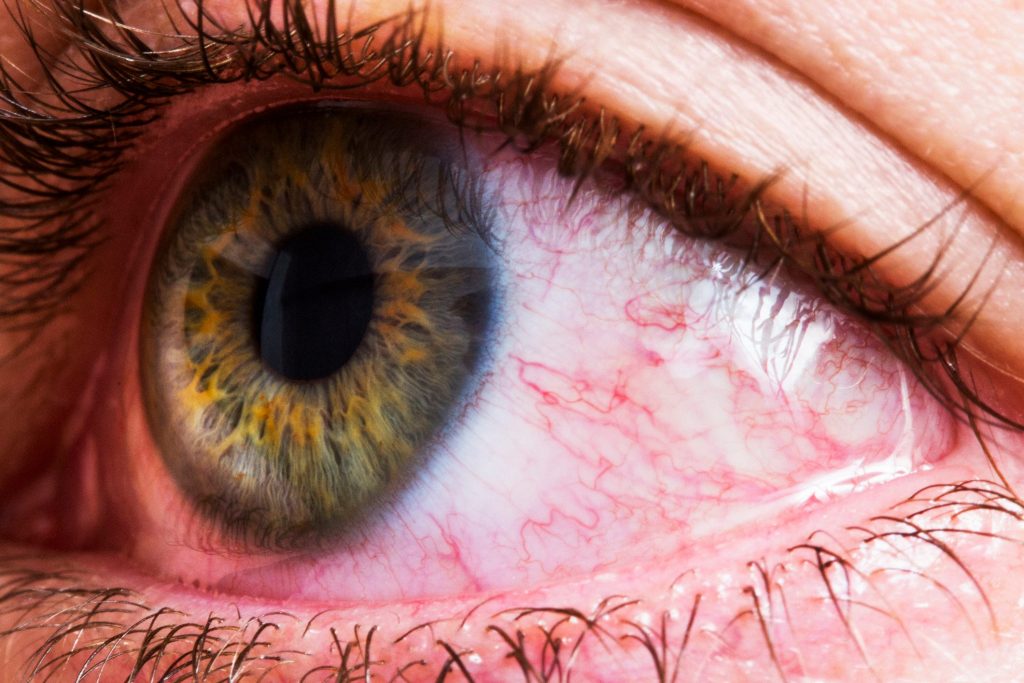
Dimitri Otis/Getty Images
- Your eyes might be red because of dry eyes caused by contact lenses or digital eye strain.
- Infections like conjunctivitis and uveitis may also cause red eyes.
- To identify the cause of red eyes, make note of any other symptoms you may be experiencing.
- Visit Insider's Health Reference library for more advice.
From dry eyes to pink eye, when your eyes are red there could be a lot of different causes. So how do you figure out the culprit?
It mainly comes down to other symptoms you experience along with the red eye. But oftentimes it can be hard to pinpoint the cause on your own, and a doctor's help is necessary for a diagnosis.
Here are 12 reasons your eyes may be red.
1. Dry eye
Dry eye is an underlying cause of many cases of red eyes – including eye strain and blepharitis.
This happens when you don't have enough tears to properly lubricate your eyes. Some reasons you might not produce enough tears include:
- Aging
- Autoimmune diseases such as rheumatoid arthritis and lupus
- Medications such as antidepressants, birth control pills, or blood pressure meds
- Laser eye surgery
You can usually tell if dry eye is causing your redness if your eyes feel noticeably dry and if you're also experiencing symptoms like burning, stinging, sensitivity to light, and blurred vision.
What to do about it: There are many options for dry eye treatment. Starr recommends:
- Using artificial tear drops to coat and lubricate the eye's surface
- Applying anti-inflammatory eye drops that ease inflammation
- Using punctal plugs (tiny silicone plugs) that you insert into your tear ducts, which helps keep tears in your eyes
- Applying warm compresses to closed eyes, so the moist heat can help unclog oil glands
2. Allergies
If you're exposed to allergens like pollen or dust, your immune system releases chemicals called histamines in response. This immune response can affect the blood vessels in your eyes, turning them red.
If allergies are causing your eye redness, you'll typically also experience symptoms like nasal congestion and sneezing.
What to do about it: One of the best ways to reduce eye redness due to allergies is to avoid the allergens that trigger a reaction in the first place, says Christopher E. Starr, MD, FACS, an ophthalmologist at Weill Cornell Medicine. Common allergens include pollen, dust, and pet dander.
He also recommends using antihistamines or topical steroids in the form of eyedrops to help with inflammation. Examples of antihistamine medications include:
- Benadryl
- Zyrtec
- Allegra
- Claritin
3. Digital eye strain
If you spend a lot of time looking at screens, digital eye strain may be to blame for your redness. This is because your eyes work harder to read text on digital screens versus reading on paper.
Starr says this is likely due to a couple of reasons:
- Digital screens have a brighter backlight which forces the eyes to work harder in order to focus, more blue light exposure,
- You're often on digital screens for longer hours than when you're reading a book or something else on paper
Additionally, you might blink less - about 66% less - when you're staring at your screens, which contributes to dry eye and associated redness.
What to do about it: Aside from following the above advice for dry eye, Starr says you can make a couple of adjustments that will help your eye strain, including remembering to blink often while looking at screens and following the 20/20/20 rule.
"Take breaks every 20 minutes, and look away into the distance (20 feet away or further), for 20 seconds or more. I recommend closing the eyes for 20 seconds or more as well to help with lubrication," says Starr.
4. Contact lens wear
Contacts may cause irritation and dry eye, leading to redness. Starr says you're more likely to experience this if:
- You wear long lenses versus daily disposables
- You leave your contact lenses for longer than intended (like when you're sleeping)
What to do about it: Aside from following dry eye treatment protocols, Starr says you can:
- Switch to daily disposable contacts, which tend to be less irritating
- Make sure you don't wear them for too long
5. Broken blood vessels
Acute pressure build up in the eyes can cause the blood vessels inside to break, Starr says. Some reasons for this may be:
- Straining (such as when you're constipated)
- Heavy lifting
- Intense coughing
- Sneezing powerfully
Your eyes will appear as a uniformly deep, dark red, which will help you tell it apart from redness caused by inflammation, which is less dark and more of a pinkish-red. You're at an increased risk for this if you take blood thinners, Starr says.
What to do about it: The main way to treat this is to let time pass. Starr says the blood will eventually reabsorb and disappear in about one or two weeks. If you're feeling a lot of discomfort, artificial tears may help.
6. Pink eye (conjunctivitis)
Pink eye is commonly caused by an infection due to bacteria or viruses, which can inflame your eyes' blood vessels, leading to redness. You'll also likely experience white, green, or yellow fluid discharge from the eye.
"[Pink eye] can vary from mild pink to frank redness, it can involve one or both eyes (often starts in one and spreads to the other), and it usually involves the entire white part of the eye, but this can vary based on severity," says Starr.
What to do about it: If your pink eye is caused by bacteria, you may need antibiotics to clear up the infection, Starr says. If antibiotics are started early, pink eye can go away within a week or so.
However, if it's viral, it may take up to two weeks to fully clear up. It's best to see a doctor if you're experiencing these symptoms so you can determine the cause and treatment for your pink eye.
You can also relieve pink eye symptoms by:
- Keeping your eyes clean, using a clean wet washcloth
- Use artificial tears to relieve discomfort
- Apply a cold compress to decrease redness and irritation
- Apply a warm compress to help soften and remove discharge
- Don't wear contacts while infected
7. Keratitis
Keratitis refers to inflammation of the cornea, which is the outermost layer of your eye. It can be caused by infections, dry eye, or even by overwearing your contacts, says Yuna Rapoport, MD, MPH, opthamologist at Manhattan Eye.
You may also experience discomfort, pain, and blurry vision. However, it's hard to identify keratitis on your own, and it's best to get checked out by an opthamologist, says Rapoport.
What to do about it: Rapoport says that the treatment depends on the cause of the keratitis:
- If the cause is an infection, she says antibiotic eye drops may be prescribed.
- If the cause is dry eye, you can try remedies such as lubricating drops or punctal plugs.
- If the cause is contact overwear, Rapoport says you need to take a "contact lens holiday" and switch to glasses until you're fully healed. Ask your doctor how long this will be for your specific case.
8. Uveitis
Uveitis is when the uvea is inflamed. The uvea is the middle layer of the eye, which lies between your cornea and iris. It may be caused by an infection, or, in many cases, by underlying autoimmune conditions, like sarcoidosis, Crohn's, or lupus, Rapoport says.
Another common symptom with uveitis is light sensitivity. However, uveiti must be properly identified and diagnosed by an ophthalmologist, usually with a microscope at the office, says Rapoport.
What to do about it: Uveitis is most commonly treated with steroid eye drops and oral steroids, says Rapoport. If someone experiences uveitis more than once, Rapoport says it's best to see a general doctor for blood work to see if an underlying condition could be responsible.
9. Scleritis
Inflammation of the sclera, which is the white part of the eye, is called scleritis. Rapoport says it can be extremely painful, and the eye will be tender to the touch. This is common in people with autoimmune diseases that cause systemic inflammation, such as rheumatoid arthritis.
What to do about it: To combat inflammation, topical steroids and oral steroids are the main treatment for scleritis, Rapoport says. If an infection is the suspected cause you may also need antibiotics.
10. Episcleritis
If the episcleral tissue, the layer of the eye that's below the conjunctiva (the clear mucus membrane) but above the sclera (the white of the eye), is inflamed, this is known as episcleritis.
Other symptoms include soreness and discomfort. Rapoport says it's difficult for you to pinpoint this as the cause for your red eye, and to differentiate it from other causes like uveitis or scleritis, which is why a visit to your eye doctor is important to determine the cause.
What to do about it: Episcleritis can clear up on it's own, but you may be prescribed steroid drops, and advised to use lubricating drops, says Rapoport.
11. Blepharitis
Blepharitis refers to inflammation of the eyelid, and it usually occurs when the oil glands in your eyes become clogged. It may be caused by anything from a buildup of bacteria leading to infection to dry eye to allergies.
The most common cause for eye redness associated with blepharitis is when the bacteria living on the eyelid gets into the eyeball itself, says Rapoport.
What to do about it: Rapoport says there are a few things you can do to treat blepharitis, including:
- Applying warm compresses
- Keeping your eyes clean
- Taking antibiotics
- Getting the clogged glands unclogged professionally
12. Acute angle-closure glaucoma
Acute angle-closure glaucoma is very rare and one of the only true medical emergencies in ophthalmology, says Rapoport.
It occurs when the pressure in the eye suddenly rises dramatically, resulting in severe pain, nausea, and vomiting. Some people are predisposed to this due to the anatomy of their eye.
"There is a drainage area in between the back and front of the eye, and if the angle of the iris is narrow, the iris can clog the area and the pressure will then go super high," says Rapoport. This is something you wouldn't know about your own eye anatomy unless a doctor told you.
What to do about it: Medical treatment must be sought out ASAP to prevent permanent damage to the eye. Rapoport says treatment involves medications that relieve the pressure in your eye and laser surgery.
Insider's takeaway
There are many causes for red eyes, ranging from relatively harmless to serious. If your red eyes are persisting or occurring with other symptoms such as pain or discharge, be sure to see a doctor to get the treatment you need and prevent further damage to the eye.
